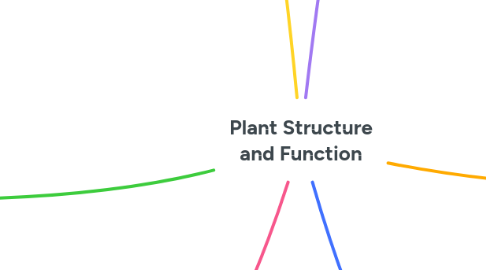
1. The Importance of Water and Inorganic Ions to Plants
1.1. Nitrate
1.1.1. Used to make amino acids, and therefore proteins and enzymes
1.1.2. Needed to make DNA, hormones, and other compounds
1.1.3. When in low levels will cause stunted growth and yellowing leaves, leading to death
1.2. Water
1.2.1. For photosynthesis. It combines with carbon dioxide to produce glucose and oxygen
1.2.2. For support. As water moves into vacuoles, the cytoplasm are forced against the cell walls, creating pressure for non-woody plants.
1.2.3. For transport. Mineral ions carried around through the xylem are powered by water transpiration
1.3. Calcium
1.3.1. Combines with pectin to make calcium pectate which holds plant cells together
1.3.2. Crucial for the membrane permeability
1.3.3. When lacking will cause yellowing leaves and dying back of growing points
1.4. Magnesium
1.4.1. Needed to produce chlorophyll essential for photosynthesis
1.4.2. Used for activation of several enzymes and nucleic acid synthesis
1.4.3. Minimal amounts will slow down growth and cause yellowing on older leaves
2. The Arrangement of Cellulose Microfibrils and Secondary Thickening's Contribution to the Physical Properties of Xylem Vessels and Sclerenchyma Fibres in Plant Fibres That Can Be Exploited by Humans
2.1. Sclerenchyma Fibres
2.1.1. Cellulose microfibrils are positioned at right angles (net-like form)
2.1.1.1. Provides the necessary flexibility needed by plants
2.1.2. Secondary Thickening
2.1.2.1. Increasing fibre strength, stiffness, and density
2.2. Xylem Vessels
2.2.1. Cellulose microfibrils are arranged vertically in a helical pattern
2.2.1.1. Giving it strength and flexibility to withstand the pressure and tension from the water transport
2.2.2. Secondary Thickening
2.2.2.1. Gives the secondary xylem hardiness and strength
3. Comparison of Plant and Animal Cell
3.1. Plant
3.1.1. Present
3.1.2. Large
3.1.3. Present
3.1.4. Absent
3.1.5. Present
3.1.6. Present
3.1.7. Present
3.2. Animal
3.2.1. Absent
3.2.2. Small
3.2.3. Absent
3.2.4. Present
3.2.5. Present
3.2.6. Present
3.2.7. Present
4. Similarities and Differences Between Sclerenchyma Fibres, Xylem Vessels, and Phloem
4.1. Sclerenchyma Fibres
4.1.1. Elongated and tapered at the end with a thin primary wall and thick secondary wall
4.1.2. Dead cells
4.1.3. Around the outside of a stem
4.1.4. Provides strength and hardness as structural support for plants.
4.2. Xylem Vessels
4.2.1. Continuous tube of interlinked tracheids with pits on its walls
4.2.2. Dead cells
4.2.3. Inside the stem in the center
4.2.4. Carry water and dissolved mineral ions from the roots to the photosynthetic parts of a plant.
4.3. Phloem
4.3.1. Long tubes composed of sieve elements, parenchyma cells and the supportive cells.
4.3.2. Living cells
4.3.3. Near the edge of the stem; close to epidermis
4.3.4. Transport dissolved product of photosynthesis to where it is needed for growth or storage as starch.
5. Structure and Function of Polysaccharides Starch and Cellulose
5.1. Polysaccharides Starch
5.1.1. Structure
5.1.1.1. A helical arrangement of amylose and amylopectin joined by glycosidic bonds (ex: 1,4 or 1,6)
5.1.1.1.1. Amylose: straight chain polysaccharide with 1,4-glycosidic bonds
5.1.1.1.2. Amylopectin: branched-chain polymer consisting of 1,4 and 1,6 glycosidic bonds
5.1.2. Function
5.1.2.1. Store energy in a dense form.
5.2. Cellulose
5.2.1. Structure
5.2.1.1. Long linear chains of β-glucose held together by 1,4-glycosidic bonds, where one unit has to be inverted for bonding to take place.
5.2.1.1.1. Single chains of cellulose are linked by hydrogen bonds between the adjacent glucose units, forming a crystalline structure.
5.2.2. Function
5.2.2.1. Provide structural shape of a plant.
5.2.2.2. Aid in mechanical strength and rigidity of plants.
5.2.2.3. Helps in absorption of water, preventing lack of moisture.
6. What is it and its function?
7. Cell Wall
8. Vacuole
9. Chloroplast
10. Centrioles
11. Function
12. Composed of
13. Position in stem
14. Structure
15. Exploited for: Production of high-quality paper, textiles, and other products that require high strength and flexibility.
16. Exploited for: Reinforcement in composite materials and in production of textiles and building materials
17. Cytoplasm
18. Plasma Membrane
19. Mitochondria
20. Structure and Ultrastructure of Plant Cells
20.1. Cell Wall
20.1.1. A freely permeable wall made of insoluble cellulose to give plants strength and support.
20.2. Chloroplast
20.2.1. Contains chlorophyll that absorb light energy to make plants' food by photosynthesis.
20.3. Amyloplast
20.3.1. Colourless organelles that store starch.
20.4. Vacuole
20.4.1. Fluid-filled space bound by a membrane for storage, waste disposal, protection, and growth.
20.5. Tonoplast
20.5.1. Specialized membrane surrounding the permanent vacuole of a plant cell, which functions to control substance movement in and out of the cell sap.
20.6. Plasmodesmata
20.6.1. Cytoplasmic bridges for cell communication and material exchange.
20.7. Pits
20.7.1. Thin areas of cell walls with secondary thickening which allows water to move between the xylem vessels and maintain an even pressure of water flow.
20.8. Middle Lamella
20.8.1. The first outer layer of a cell wall mainly made of pectin to hold the cell walls of adjacent plant cells together.
